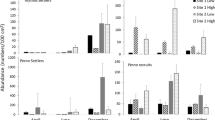Abstract
Variation in the recruitment of benthic marine invertebrates is often attributed to the interaction of the supply of new individuals to a habitat and the availability of space for colonisation when they arrive. Also important in determining variation in recruitment is the response of the larvae to the characteristics of the habitat. Larvae of many benthic marine invertebrates have shown great specificity of requirements in setting their limits of distribution at the time of selection of a habitat. The tubeworm Galeolaria caespitosa shows great variation in recruitment from place to place on rocky intertidal seashores and is a gregarious animal with larvae showing directed responses to conspecific adults on the substratum. I hypothesised that, if variation in recruitment of G. caespitosa were independent of conditions on the substratum, the magnitude of recruitment in patches of the same shape but different sizes cleared within continuous mats of conspecific adults would be directly related to the area available for colonisation in the patch. Alternatively, if variation in recruitment were due to the response of larvae to conspecific adults on the substratum, the magnitude of recruitment would be a function of the perimeter of the patch, which, given patches of the same shape, is a measure of the influence of conspecific adults in that patch. To distinguish between these alternatives, small (area = 25 cm2; perimeter = 20 cm) and large (area = 225 cm2; perimeter = 60 cm) square patches were cleared within continuous mats of conspecific adults at four sites and recruitment of G. caespitosa was monitored over two seasons of recruitment. The density of recruits per unit area was, on average, almost three times greater in small than in large patches, indicating that recruitment of G. caespitosa is not directly related to the area of the patch. In contrast, the density of recruits per unit perimeter was not significantly different between small and large patches, indicating that recruitment of G. caespitosa is related to the proximity of conspecific adults in the patch. Therefore, at a given site, the perimeter of patches within mats of G. caespitosa is a better predictor of the relative magnitude of recruitment among patches than that provided by their areas. These results are contrary to many models of invertebrate recruitment that assume close linkage between available space on the substratum and settlement. Moreover, they highlight the importance of behavioural responses of animals at the time of selection of habitat in accounting for variation in recruitment. For populations of organisms that display gregarious behaviour at settlement, or conspecific attraction, this direct relationship between the perimeter of patches and recruitment could be used as a tool in restoring populations to disturbed habitats. The added benefit of such facilitative interactions in restoring populations is that they provide increasing returns to the population for a given supply of potential colonists to a habitat.
Similar content being viewed by others
Author information
Authors and Affiliations
Additional information
Received: 1 November 1996 / Accepted: 20 January 1997
Rights and permissions
About this article
Cite this article
Minchinton, T. Life on the edge: conspecific attraction and recruitment of populations to disturbed habitats. Oecologia 111, 45–52 (1997). https://doi.org/10.1007/s004420050206
Issue Date:
DOI: https://doi.org/10.1007/s004420050206




